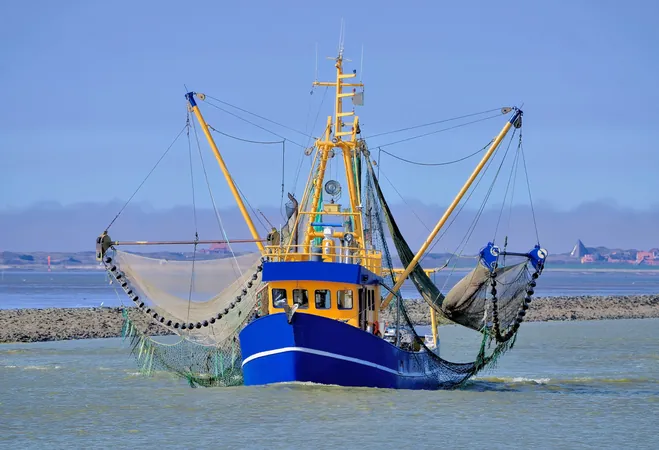
The Hidden Truth: How Trawling is Accelerating Climate Change
2024-11-05
Author: Li
The Ocean's Forgotten Guardian
Deep-sea habitats do more than just host marine life; they serve as critical carbon sinks, absorbing more carbon than they emit. The ocean floor operates like a vault, storing carbon safely in sediments for millennia. When trawling disrupts this sediment, it jeopardizes this finely-tuned ecological balance.
Shocking Findings on Carbon Storage
A groundbreaking study conducted by teams from Helmholtz-Zentrum Hereon, Alfred Wegener Institute, and GEOMAR Helmholtz Center for Ocean Research Kiel has shed light on how bottom trawling affects carbon storage, particularly in the North Sea. The researchers analyzed over 2,300 sediment samples and discovered alarming results.
Dr. Wenyan Zhang, lead author of the study, stated, “Samples from heavily trawled areas showed significantly lower organic carbon content compared to those from less impacted zones. Our findings definitively link this decline to intense trawling activities.” This research marks a pivotal shift in understanding the magnitude of trawling's environmental impact.
Carbon Emission Alarms
The repercussions of trawling go beyond the immediate area. Computer simulations indicated a steady drop in seabed carbon levels over recent decades, primarily due to the relentless activities of trawlers. Soft, muddy seabeds suffer the most, as the disturbance releases stored carbon into the surrounding water, where microorganisms convert it to CO2, a potent greenhouse gas driving climate change.
Alarmingly, Dr. Zhang's team estimates that trawling in the North Sea alone contributes about 1 million tons of CO2 emissions annually. On a global scale, this figure skyrockets to around 30 million tons.
The Urgent Need for Seabed Protection
This research underscores an urgent call to enhance protections for our ocean floors, specifically targeting vulnerable, carbon-rich muddy habitats, often neglected in favor of hard-bottom ecosystems. Traditional marine protections have aimed at coral reefs and sandy areas that are rich in biodiversity but may not hold as much carbon.
Dr. Zhang points out, “Our findings can refine marine spatial planning policies by assessing the potential carbon benefits of limiting or ceasing bottom trawling in sensitive areas.” Rethinking strategies to establish no-trawling zones can significantly bolster both carbon storage and marine biodiversity.
The Recovery Challenge
The long-term impacts of disturbed seabed sediments are profound. Once sediments are displaced, they can take years, if not decades, to recover their carbon-storing capabilities. Continuous trawling can hinder this recovery, permanently impairing the ocean’s ability to store carbon effectively.
The Climate Trawling Connection
The implications of these findings extend far beyond the fishing industry. As our oceans struggle to retain their natural carbon capture abilities, we face escalating challenges in combating climate change. Researchers urge immediate action to promote sustainable fishing practices and regulate trawling operations.
This significant study—published in the esteemed journal Nature Geoscience—encourages a reevaluation of our relationship with the oceans. By prioritizing the protection of our vulnerable marine ecosystems, we can mitigate climate change and foster a healthier planet for generations to come.
In the battle against climate change, every action counts. Will the fishing industry embrace sustainable trawling practices, or will the clock run out on our ocean's capacity to combat climate change? The future of our planet may very well depend on it.



 Brasil (PT)
Brasil (PT)
 Canada (EN)
Canada (EN)
 Chile (ES)
Chile (ES)
 Česko (CS)
Česko (CS)
 대한민국 (KO)
대한민국 (KO)
 España (ES)
España (ES)
 France (FR)
France (FR)
 Hong Kong (EN)
Hong Kong (EN)
 Italia (IT)
Italia (IT)
 日本 (JA)
日本 (JA)
 Magyarország (HU)
Magyarország (HU)
 Norge (NO)
Norge (NO)
 Polska (PL)
Polska (PL)
 Schweiz (DE)
Schweiz (DE)
 Singapore (EN)
Singapore (EN)
 Sverige (SV)
Sverige (SV)
 Suomi (FI)
Suomi (FI)
 Türkiye (TR)
Türkiye (TR)
 الإمارات العربية المتحدة (AR)
الإمارات العربية المتحدة (AR)